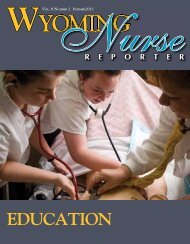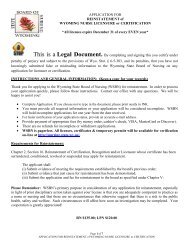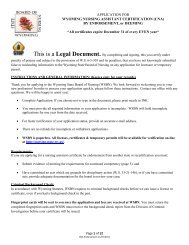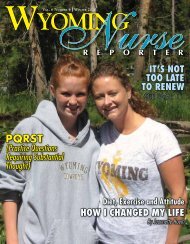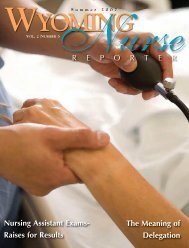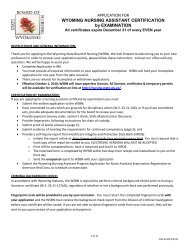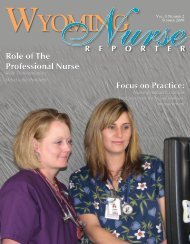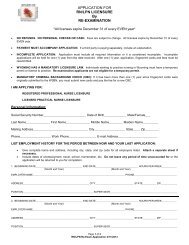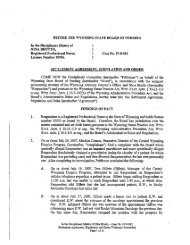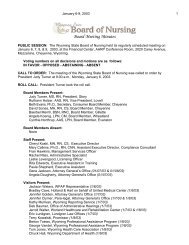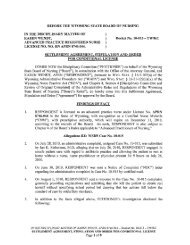Nurse Reporter Spring 2009 - Wyoming State Board of Nursing
Nurse Reporter Spring 2009 - Wyoming State Board of Nursing
Nurse Reporter Spring 2009 - Wyoming State Board of Nursing
Create successful ePaper yourself
Turn your PDF publications into a flip-book with our unique Google optimized e-Paper software.
Patti Gardner, MSN, CNM, PMHNP-BC<br />
The History <strong>of</strong> Today’s<br />
<strong>Nurse</strong> Practitioner<br />
<strong>Nurse</strong> practitioners are advanced practice<br />
nurses prepared at the master’s degree level<br />
who provide quality care similar to that <strong>of</strong> a<br />
physician. Just as physicians do, nurse practitioners<br />
diagnose and treat a wide range <strong>of</strong><br />
health care problems. In addition to diagnosis<br />
and treatment, nurse practitioners focus on<br />
health promotion, disease prevention, education<br />
and counseling.<br />
There are about 120,000 nurse practitioners<br />
practicing today and approximately 6,000<br />
enter the field each year in a variety <strong>of</strong> specialties<br />
(American Academy <strong>of</strong> <strong>Nurse</strong> Practitioners,<br />
2007). There are almost as many kinds<br />
<strong>of</strong> nurse practitioners as there are medical specialties;<br />
acute care, adult health, family health,<br />
gerontology health, neonatal health, oncology,<br />
pediatric, psychiatric and women’s health, as<br />
well as many others who practice in sub-specialty<br />
areas such as cardiovascular, dermatology,<br />
sports medicine and occupational health.<br />
<strong>Nurse</strong> practitioners have been providing<br />
health care for over 43 years. In the 1950s and<br />
60s, increasing specialization in medicine led<br />
to a lack <strong>of</strong> primary care services; especially<br />
in rural areas. As a result, physicians began<br />
working with and mentoring skilled and experienced<br />
nurses. Focusing on health promotion,<br />
disease prevention, and the health <strong>of</strong> children<br />
and families, a registered nurse named Loretta<br />
Ford and Dr. Henry Silver started the first nurse<br />
practitioner training program at the University<br />
<strong>of</strong> Colorado in 1965; preparing Pediatric <strong>Nurse</strong><br />
Practitioners (O’Brien, 2003).<br />
<strong>Nurse</strong> practitioners were initially opposed<br />
by physicians and nurses alike. Physicians accused<br />
nurse practitioners <strong>of</strong> practicing medicine<br />
and nurses believed that the nurse practitioners<br />
were no longer practicing nursing.<br />
Thus, the role was born into an environment<br />
<strong>of</strong> informal training, lack <strong>of</strong> credentialing, increasing<br />
advances in medical care, and opposition<br />
(O’Brian, 2003).<br />
Those first nurse practitioners were pioneers;<br />
many <strong>of</strong> whom had grown tired and<br />
disillusioned with nursing but were willing to<br />
give it one more try. Most entered nurse practitioner<br />
programs with no guarantee <strong>of</strong> a job<br />
when they graduated. They knew they would<br />
have many critics and that their new roles<br />
had to combine both the best <strong>of</strong> nursing along<br />
with new assessment and diagnostic skills (Edmunds,<br />
2000).<br />
In 1976, the first publication <strong>of</strong> clinical and<br />
research articles specifically for nurse practitioners,<br />
The <strong>Nurse</strong> Practitioner: The American<br />
Journal <strong>of</strong> Primary Care was published. In<br />
1982 an article was published in the journal<br />
that described the barriers nurse practitioners<br />
must overcome in order to survive. The article<br />
served as a catalyst for nurse practitioners to<br />
join forces and work together. The American<br />
Academy <strong>of</strong> <strong>Nurse</strong> Practitioners organized in<br />
1985 became the first organization to represent<br />
nurse practitioners. Not until 1992 did nurse<br />
practitioners move to develop greater cohesion<br />
and unity as a group. A national summit <strong>of</strong><br />
nurse practitioners was established and later<br />
formalized into the American College <strong>of</strong> <strong>Nurse</strong><br />
Practitioners (Edmunds, 2000).<br />
<strong>Nurse</strong> practitioners have legislatively defined<br />
the advanced practice role in all 50<br />
states. New nurse practice acts were passed as<br />
well as some degree <strong>of</strong> prescriptive authority<br />
for nurse practitioners in all 50 states by 1999.<br />
In some states, success was achieved by working<br />
with other advance practice nurses such as<br />
nurse midwives, nurse anesthetists and clinical<br />
nurse specialists. There has been some confusion<br />
in titles and roles <strong>of</strong> nurses with a master’s<br />
degree, even among the nursing community.<br />
<strong>Nurse</strong> practitioners are advanced practice<br />
nurses. advanced practice nurses (APNs) also<br />
include nurse anesthetists, clinical nurse specialists,<br />
and certified nurse midwives. Over<br />
the years, the role <strong>of</strong> the nurse practitioner has<br />
become more defined and accepted into the<br />
mainstream.<br />
Education for nurse practitioners was initially<br />
slow in implementation. Educators set<br />
up certificate programs to prepare nurse practitioners<br />
quickly in order to fill gaps in the<br />
healthcare field. Since 2007, all nurse practitioners<br />
are required to have a master’s degree.<br />
Certification is common, and sometimes<br />
required, for the four advanced practice nursing<br />
specialties: clinical nurse specialists, nurse<br />
anesthetists, nurse-midwives and nurse practitioners.<br />
Upon completion <strong>of</strong> their educational<br />
programs, most advanced practice nurses become<br />
nationally certified in their area <strong>of</strong> specialty<br />
(US Department <strong>of</strong> La bor, Bureau <strong>of</strong><br />
Statistics, <strong>2009</strong>). In many states, including<br />
<strong>Wyoming</strong>, certification in a specialty is required<br />
in order to practice that specialty.<br />
About 31 percent <strong>of</strong> all <strong>Nurse</strong> Practitioners<br />
are family nurse practitioners, 18 percent are<br />
adult nurse practitioners, and 18 percent are<br />
pediatric nurse practitioners. The remaining<br />
33 percent <strong>of</strong> nurse practitioners are practicing<br />
in geriatric, women’s health, neonatal, acute<br />
care, psychiatric or other specialty programs<br />
(<strong>Nurse</strong> Practitioner Alternatives, <strong>2009</strong>). The<br />
largest majority <strong>of</strong> nurse practitioners provide<br />
primary care.<br />
No other group <strong>of</strong> health care pr<strong>of</strong>essionals<br />
has been evaluated and researched in the<br />
areas <strong>of</strong> quality <strong>of</strong> care, patient acceptance,<br />
satisfaction and cost-effectiveness as the nurse<br />
practitioner. As a result, there is a wealth <strong>of</strong><br />
data to demonstrate that nurse practitioners<br />
are competent in delivering primary care that<br />
is satisfactory, acceptable to patients and cost<br />
effective; as well as providing increased access<br />
to care. This is not to say that there are not<br />
challenges and roadblocks yet to overcome.<br />
While nurse practitioners have become fully<br />
integrated into the health care delivery system,<br />
many are legally and financially dependent on<br />
physicians for their jobs due to reimbursement<br />
exclusions and other inequities.<br />
<strong>Nurse</strong> practitioners deliver a unique blend<br />
<strong>of</strong> medical and nursing care in the almost 600<br />
million visits they make with patients each<br />
year (American Academy <strong>of</strong> <strong>Nurse</strong> Practitioners,<br />
2007)to primarily the indigent, migrant,<br />
young or elderly. Since the inception <strong>of</strong> the<br />
role, nurse practitioners have envisioned and<br />
succeeded in improving health care and access<br />
to health care. In the future, those numbers<br />
are only expected to grow in response to the<br />
demand for affordable quality health care.<br />
Patti now lives in Lincoln,<br />
Nebraska<br />
References<br />
American Academy <strong>of</strong> <strong>Nurse</strong> Practitioners.<br />
www.aanp.org (accessed February 5, <strong>2009</strong>).<br />
Edmunds, M. (2000). <strong>Nurse</strong> Practitioners:<br />
Remembering the Past, Planning for the Future.<br />
Medscape <strong>Nurse</strong>s; pp1-5.<br />
<strong>Nurse</strong> Practitioner Alternatives.<br />
www.npedu.com/faq1.htm (accessed February<br />
2, <strong>2009</strong>).<br />
O’Brian, John Michael (2003). How <strong>Nurse</strong><br />
Practitioners Obtained Provider Status: Lessons<br />
for Pharmacists. Am J Health-Syst Pharm<br />
60(22), 2301-2307.<br />
US Department <strong>of</strong> Labor, Bureau <strong>of</strong> Labor<br />
Statistics. www.bls.gov/oco/ocos083.htm (accessed<br />
February 8, <strong>2009</strong>).<br />
22 Wy o m i n g Nu r s e Re p o r t e r



